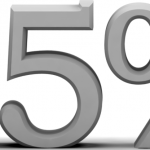Sell in May? A short-term trader's perspective
‘Sell in May and Go Away'. If you've traded stocks for more than a few years you've probably heard this adage, always muttered in the same tone of voice as your grandfather used when sharing his decades worth of experience.
You are starting to see mention of this concept in various articles, as May is once again approaching. Is this really a good time to close out positions and sit on the sidelines for six months?
To see, let's look at the three major stock indexes and how they have performed historically. I'll backtest each of the three major indexes, looking for the net gain or loss from the beginning of May through the end of October.
The backtest approach is simple. For each year in the past, I'll take the value of the index on the Open of the first trading day in May and the Close of the last trading day in various weeks afterwards. The charts below show the results from one through twenty-six weeks after the first trading day in May. I'll focus on the past thirty years, 1980 through 2010. The data I'm using for the NASDAQ Composite only goes back to 1990, and later in this analysis I'll use individual stock data for components of the S&P 500 which becomes more difficult to do the further back I go. From my years of research, I've come to think of the 80's as the start of ‘modern trading', as options trading, mutual funds, and numerous other financing and trading approaches became popular.
Let's start with the Dow Jones Industrials Average. I'll analyze taking a theoretical Long position (that is, I'll assume I buy the stock) on the first trading day of May and closing it out from one to twenty-six weeks later. What I am looking for is either a net decline in value or an insignificant net gain that wouldn't make it worth trading.
I see above that indeed, holding a DJIA position for the next several months would hardly have been profitable in the past. After six months I would have averaged only a 1.4% gain per year.
The Sell in May and Go Away analysis done by other analysts in the past usually say most of the gains come in the November through April period. So how would the DJIA have done during that period?
Well, that looks a lot better. An 8.6% return over six months is significantly better than a 1.4% gain. Also, we see a steadily rising return throughout the six month period after November 1st.
Let's compare the S&P 500. First, the six months following May 1st:
Now, the six months following November 1st:
Again, a similar result. We'll do it once more with the NASDAQ Composite, an index more heavily populated with technology and faster-growth companies. First, the May 1st period:
Now, the November 1st period:
There's not as much difference here. While I would make only one-third of your year's profit in the half-year from May through October, I wouldn't view it as worth it to sit out that period.
Should a short-term trader implement this approach?
If you're an investor, you could implement this approach (assuming you did it over a long enough period where the results averaged out similar to the past) to lower the risk, while lowering the return only slightly.
For active traders, the charts, and the overall philosophy, should mean little. Active traders are not likely to close out all positions in early May and wait until late October to reenter. They also are not likely to trade just the indexes (via surrogates). As is often the case, a focused, selective approach to finding good trade candidates can more than offset any historically negative bias.
Is analysis of indexes particularly useful?
It may not be. A professional trader will not only select trade candidates via a rigorous filtering process, but will also implement a clearly defined trading and money management plan.
A common approach is to plan on risking the same amount on each trade. Say I have a $40,000 account allocated for short-term trading. I decide to risk 5% maximum on any individual stock trade, or in this case $2,000.
Once I have selected a stock trade, I'd buy only as many shares as 5%, or $2,000, would allow.
When you implement a trading approach like this, every stock has an equal effect. If stock ‘A' goes up 20%, then the overall account is increased by 1%.
That's not the case with indexes. If stock ‘A' is in the S&P 500 and stock ‘A' goes up 20%, the index will not rise exactly .04% (20% / 500), because the stocks have different weightings within the index. A small number of stocks may have a much larger influence on the overall index.
So what would the results of the May (and November) seasonals be if every stock was considered equal and purchased according to the above trading plan?
The following two charts were formed by taking the current 500 component stocks in the S&P 500 index, and calculating the overall average of their individual yearly gains. Of course many of the current S&P 500 stocks weren't in existence back in 1980, the start of this analysis. But enough were that the results are valid. Here's the May through October results:
Now, here's the November through April results:
My opinion is that it overall, it would have been profitable trading year-round – much more than sitting out half of each year. Also, this analysis assumes you'd trade every stock equally without filtering out the poorer candidates each year and not using any returns-enhancing leverage such as margin or options.
There may be individual periods where it may be prudent to stay out of the game and sit back and watch the market action. A few days, or even a couple of weeks, when the market seems confused or lifeless, can be time well spent. But curtailing trading for half the year, based on an analysis of index gains or losses that is not representative of how a professional trader would actually trade the components makes little sense.
Of course, there's much more you need to know and many more stocks you can capitalize upon each and every day. To find out more, type in www.markettamer.com/seasonal-forecaster
By Gregg Harris, MarketTamer Chief Technical Strategist
Copyright (C) 2013 Stock & Options Training LLC
Unless indicated otherwise, at the time of this writing, the author has no positions in any of the above-mentioned securities.
Gregg Harris is the Chief Technical Strategist at MarketTamer.com with extensive experience in the financial sector.
Gregg started out as an Engineer and brings a rigorous thinking to his financial research. Gregg's passion for finance resulted in the creation of a real-time quote system and his work has been featured nationally in publications, such as the Investment Guide magazine.
As an avid researcher, Gregg concentrates on leveraging what institutional and big money players are doing to move the market and create seasonal trend patterns. Using custom research tools, Gregg identifies stocks that are optimal for stock and options traders to exploit these trends and find the tailwinds that can propel stocks to levels that are hidden to the average trader.
Related Posts
Also on Market Tamer…
Follow Us on Facebook

 Why Sony Stock Swooned on Monday
Why Sony Stock Swooned on Monday



